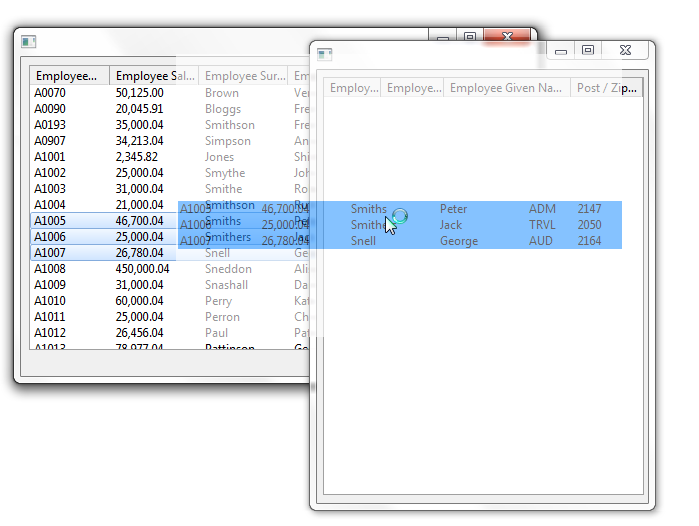
この例では、ドラッグ・アンド・ドロップ操作で複数の従業員の詳細を操作し、その詳細を1つのEmployeeオブジェクトに保存することを除くとリスト・コレクションの例1と同じです。

Employeeオブジェクト
Employeeオブジェクトは、従業員の詳細を保存するために使用されます。このオブジェクトは、その後、コレクション内でドラッグ・アンド・ドロップ操作で使用されます。
オブジェクトは、以下の従業員のプロパティを定義し、公開しています。
コレクションの定義
List コレクションは、このドラッグ操作でPayLoadとして動的に作成されます。#EmployeeオブジェクトのList コレクションです。コレクションに挿入されるEmployeeオブジェクトを保存するために#DragEmployee変数が作成されます。コレクションは動的なので、明示的にSET_REFコマンドで参照を設定する必要があります。
Define_Com Class(#Prim_LCOL<#Employee>) Name(#PayLoadList) Reference(*Dynamic)
Define_Com Class(#Employee) Name(#DragEmployee) Reference(*Dynamic)
Set_Ref Com(#PayLoadList) To(*Create_as #Prim_LCOL<#Employee>)
コレクションへのアイテムの追加
選択されたEmployeeオブジェクトをList コレクションに追加するために、Selectlistループが使用されます。List コレクションは、ドラッグ操作のPayLoadとして割り当てられます。
Selectlist Named(#DRAG_LIST)
Continue If('#Drag_List.Currentitem.Selected *ne True')
Set_Ref Com(#DragEmployee) To(*Create_as #Employee)
Set Com(#DragEmployee) Pempno(#Empno) Pgivename(#GiveName) Psurname(#Surname) Psalary(#Salary) Pdepartment(#Deptment) Ppostcode(#PostCode)
Invoke Method(#PayLoadList.Insert) Item(#DragEmployee)
Endselect
Set_Ref Com(#PayLoad) To(#PayLoadList)
コレクションからのアイテムの取得
2つめのフォームのリストのDragDropイベントには、List コレクションが定義され、選択された従業員のコレクションを含むPayLoadがキャストされます。
Define_Com Class(#Prim_LCOL<#Employee>) Name(#EmployeePayLoad) Reference(*Dynamic)
Set_Ref Com(#EmployeePayLoad) To(*Dynamic #PayLoad)
List コレクションの先頭から末尾まで、For/EndForループで従業員の詳細を取得します。
For Each(#EmployeeObject) In(#EmployeePayLoad)
Change Field(#EMPNO) To('#EMPLOYEEOBJECT.PEMPNO')
Change Field(#GIVENAME) To('#EMPLOYEEOBJECT.PGIVENAME')
Change Field(#SURNAME) To('#EMPLOYEEOBJECT.PSURNAME')
Change Field(#POSTCODE) To('#EMPLOYEEOBJECT.PPOSTCODE')
Add_Entry To_List(#DROP_LIST)
Endfor
List コレクションの例2のソース・コード
Employeeオブジェクト
オブジェクトを再利用可能パーツとして作成します。この例では、#Employeeという名前にします。
Function Options(*DIRECT)
Begin_Com Role(*EXTENDS #PRIM_OBJT)
* ----------------------------
* This is an "Employee" object
* ----------------------------
* Define the member variables that define an "Employee" object ....
Define_Com Class(#Empno)
Define_Com Class(#GiveName)
Define_Com Class(#SurName)
Define_Com Class(#Deptment)
Define_Com Class(#Salary)
Define_Com Class(#PostCode)
* Publish the properties that an "Employee" exposes .....
Define_Pty Name(pEmpno) Get(*Auto #Empno) Set(*Auto #Empno)
Define_Pty Name(pGiveName) Get(*Auto #GiveName) Set(*Auto #GiveName)
Define_Pty Name(pSurName) Get(*Auto #SurName) Set(*Auto #SurName)
Define_Pty Name(pDepartment) Get(*Auto #Deptment) Set(*Auto #Deptment)
Define_Pty Name(pSalary) Get(*Auto #Salary) Set(*Auto #Salary)
Define_Pty Name(pPostCode) Get(*Auto #PostCode) Set(*Auto #PostCode)
End_Com
初めのフォーム
Function Options(*DIRECT)
Begin_Com Role(*EXTENDS #PRIM_FORM) Clientheight(319) Clientwidth(509) Dragstyle(Automatic) Height(346) Left(255) Top(111) Width(517)
* The Drag List Definition.Note the use of the DragStyle(Automatic) property
Define_Com Class(#PRIM_LTVW) Name(#DRAG_LIST) Displayposition(1) Dragstyle(Automatic) Fullrowselect(True) Height(285) Left(8) Parent(#COM_OWNER) Tabposition(1) Top(8) Width(465)
Define_Com Class(#PRIM_LVCL) Name(#LVCL_1) Displayposition(1) Parent(#DRAG_LIST) Source(#EMPNO) Width(18)
Define_Com Class(#PRIM_LVCL) Name(#LVCL_2) Displayposition(2) Parent(#DRAG_LIST) Source(#SALARY) Width(20)
Define_Com Class(#PRIM_LVCL) Name(#LVCL_3) Displayposition(3) Parent(#DRAG_LIST) Source(#SURNAME) Width(20)
Define_Com Class(#PRIM_LVCL) Name(#LVCL_4) Displayposition(4) Parent(#DRAG_LIST) Source(#GIVENAME) Width(20)
Define_Com Class(#PRIM_LVCL) Name(#LVCL_5) Displayposition(5) Parent(#DRAG_LIST) Source(#DEPTMENT) Width(11)
Define_Com Class(#PRIM_LVCL) Name(#LVCL_6) Displayposition(6) Parent(#DRAG_LIST) Source(#POSTCODE) Width(20) Widthtype(Remainder)
* Define the drop form (change #LCOL00004 to the name you give to the second form)
Define_Com Class(#LCOL00004)
* ===============================
* Handle main form initialization
* ===============================
Evtroutine Handling(#com_owner.Initialize)
* Fill the drag list with employee details
Select Fields(#DRAG_LIST) From_File(PSLMST)
Add_Entry To_List(#DRAG_LIST)
Endselect
* Show the drop list form (change #LCOL00004 to the name you give to the second form)
Invoke Method(#LCOL00004.ShowForm)
Endroutine
* ==================================
* Handle starting the drag operation
* ==================================
Evtroutine Handling(#Drag_List.StartDrag) Draglist(#DragList) Continue(#Continue) Payload(#PayLoad)
Define_Com Class(#Prim_LCOL<#Employee>) Name(#PayLoadList) Reference(*Dynamic)
Define_Com Class(#Employee) Name(#DragEmployee) Reference(*Dynamic)
* Dynamically create the list collection that is to to be the "payload"
* for this drag operation.It is a list collection of #Employee objects
Set_Ref Com(#PayLoadList) To(*Create_as #Prim_LCOL<#Employee>)
* Now fill the list collection with the employees that are selected
Selectlist Named(#DRAG_LIST)
Continue If('#Drag_List.Currentitem.Selected *ne True')
Set_Ref Com(#DragEmployee) To(*Create_as #Employee)
Set Com(#DragEmployee) Pempno(#Empno) Pgivename(#GiveName) Psurname(#Surname) Psalary(#Salary) Pdepartment(#Deptment) Ppostcode(#PostCode)
Invoke Method(#PayLoadList.Insert) Item(#DragEmployee)
Endselect
* Finished.Set the correct return values
Set Com(#Continue) Value(True)
Set_Ref Com(#PayLoad) To(#PayLoadList)
Set Com(#DragList) Dragliststyle(Selection)
Endroutine
End_Com
2番目のフォーム
Function Options(*DIRECT)
Begin_Com Role(*EXTENDS #PRIM_FORM) Clientheight(433) Clientwidth(331) Dragstyle(Automatic) Formstyle(StayOnTopChild) Height(460) Left(453) Top(49) Width(339)
* The Drop List Definition
Define_Com Class(#PRIM_LTVW) Name(#DROP_LIST) Displayposition(1) Dragstyle(Automatic) Fullrowselect(True) Height(418) Left(6) Parent(#COM_OWNER) Tabposition(1) Top(7) Width(321)
Define_Com Class(#PRIM_LVCL) Name(#LVCL_1) Displayposition(1) Parent(#DROP_LIST) Source(#EMPNO) Width(18)
Define_Com Class(#PRIM_LVCL) Name(#LVCL_3) Displayposition(2) Parent(#DROP_LIST) Source(#SURNAME) Width(20)
Define_Com Class(#PRIM_LVCL) Name(#LVCL_4) Displayposition(3) Parent(#DROP_LIST) Source(#GIVENAME) Width(40)
Define_Com Class(#PRIM_LVCL) Name(#LVCL_6) Displayposition(4) Parent(#DROP_LIST) Source(#POSTCODE) Width(20) Widthtype(Remainder)
* ===============================
* Handle Drag Over the drop list
* ===============================
Evtroutine Handling(#Drop_List.DragOver) Acceptdrop(#AcceptDrop) Payload(#PayLoad)
* If the payload to be dropped is a list collection of employees
* then accept it otherwise reject it .....
If_Ref Com(#PayLoad) Is(*Instance_of #Prim_LCol<#Employee>)
Set Com(#AcceptDrop) Value(True)
Else
Set Com(#AcceptDrop) Value(False)
Endif
Endroutine
* =========================================
* Handle the actual drop into the drop list
* =========================================
Evtroutine Handling(#Drop_List.DragDrop) Payload(#PayLoad)
Define_Com Class(#Prim_LCOL<#Employee>) Name(#EmployeePayLoad) Reference(*Dynamic)
* Cast the payload as a list collection of employee objects ....
Set_Ref Com(#EmployeePayLoad) To(*Dynamic #PayLoad)
* Fill drop list with all the employee numbers in the payload ...
Clr_List Named(#DROP_LIST)
For Each(#EmployeeObject) In(#EmployeePayLoad)
Change Field(#EMPNO) To('#EMPLOYEEOBJECT.PEMPNO')
Change Field(#GIVENAME) To('#EMPLOYEEOBJECT.PGIVENAME')
Change Field(#SURNAME) To('#EMPLOYEEOBJECT.PSURNAME')
Change Field(#POSTCODE) To('#EMPLOYEEOBJECT.PPOSTCODE')
Add_Entry To_List(#DROP_LIST)
Endfor
Endroutine
End_Com